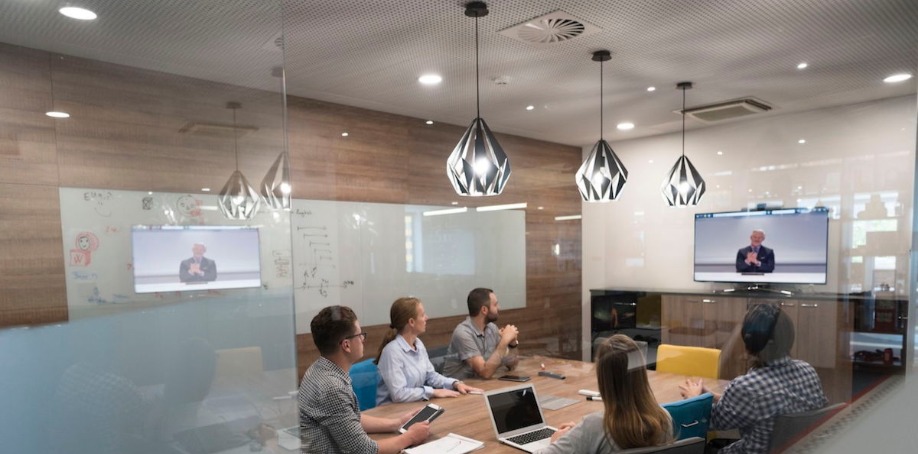
Once upon a time, AV systems were isolated projects. Integrators were called in to outfit a conference room or an auditorium space, and their work focused on the equipment and its connections, not on corporate strategy.
Today, the situation has changed.
“It's not just about a one-off AV project anymore,” consultant Joseph Arena tells Commercial Integrator. “Companies are starting to spend money on redoing office spaces. They're looking for more optimization out of their office space.”
As remote work becomes more common and technological tools saturate the workplace, integrators' projects do more than merely make AV tools useable. Integrators also have the power to improve the efficiency of the people who use those tools.
Here's how integrators contribute to a more efficient workforce — and what integrators and companies need to know to maximize this dimension of the integrator-client relationship.
AV Over IP and Considerations for Workplace Efficiency
Computer networks have evolved over time, from their humble beginnings as methods of sending bits of data to other computers to today's information-heavy video and audio streaming. Video in particular has always posed a problem for computer networks due to its high data load and tendency to break down in transit, notes industry analyst Phil Hippensteel, Ed.D., at Sound & Video Contractor.
Yet video is essential to the efficiency of today's workforce, particularly when remote teams are involved. Remote workers are 13 percent more efficient than non-remote workers, according to researchers Nicholas Bloom, James Liang, John Roberts and Zhichun Jenny Ying. Videoconferencing helps teams stay on topic, avoid multitasking, and share information more efficiently than audioconferencing or email alone, as an article at Ingram Macro noted.
Web and videoconferencing is undergoing an “explosive demand” among employees working in huddle rooms, which are small collaborative workspaces, writes Phillip Loeper, senior marketing manager at Ecolab. “It's no picnic to conduct a video conferencing meeting in an open space cubicle.”
AV over IP provides greater flexibility in installation than previous matrix-switch-based installations, allowing integrators to play a key role in outfitting huddle spaces and similar workspaces for optimal video, audio, and computer-based collaborative uses. To do so, however, integrators and their clients will need to talk about the goals of the space and the company — not just about equipment and costs.

Integrating for Peak Efficiency: A How-To Guide for Integrators and Companies
Do staff have the tools they need for effective collaboration? A 2016 Prysm report sheds some startling light on the question:
- 24 percent of workers surveyed said their workplace was equipped with up to date technology, including AV tools.
- 26 percent of workers said they had the workplace tools they needed to collaborate successfully.
- 83 percent of workers said that time and location weren't barriers to their productivity, as long as they had the right collaboration tools.
With so many workers convinced they can collaborate productively with the right tools, ensuring the tools are “right” becomes a key opportunity for companies. It's also a key opportunity for integrators to build AV over IP projects that exceed clients' expectations and improve the efficiency of the entire team.
Here are a handful of questions for integrators and clients to consider:
- What is the ultimate goal of the project or space? Is it to improve team efficiency, boost engagement, open up offerings or client opportunities for the business, or something else? Put the big picture goal in place, and keep it in mind as the project proceeds.
- What on-site support is available? AV over IP has opened up opportunities for IT staff to assist in AV troubleshooting, so it's worthwhile to coordinate early with IT teams.
- Is there a long-term expansion plan for the project, and if so what does it entail? AV over IP offers more flexibility than matrix-switch-based AV when it comes to expansion. Planning the initial project with scalability in mind can make growth less painful and allow teams to stay productive during transitions.
By understanding the client's overall vision and goal, integrators can provide better recommendations to fulfill that vision and goals while keeping efficiency high.

Case Studies
Integrators who see their client projects improve workplace productivity in real time are often inspired to do the same for their own teams.
Such is the case with Tierney Brothers, which considered worker efficiency when the company moved into a new building with two goals: to foster collaboration and to create a space the staff were proud to show to potential clients.
The initial challenge was finding a facility that “works best for us from a business side,” Tierney CEO Rob Gag tells Commercial Integrator. “That is, integrating technology in collaborative spaces and furniture to enhance communication and lead to better business outcomes. That was our mission.”
“We installed multiple hotel offices, small huddle spaces, places that are easy to collaborate in,” adds project manager Trent Fettig, “so our project managers can grab our engineers and our installers quickly, on the fly, and have impromptu meetings or scheduled meetings. We're bringing customers into the same spaces [where] we're having internal meetings.”
The switch from cubicles to a more open design — with about 20 collaboration spaces in all — was a culture shift for Tierney as well. So far, Gag reports that change has been for the better; the collaboration spaces see regular use on a daily basis.
The new building greets visitors with a mosaic video wall. A 2×2 video wall in one of the large conference rooms enables the use of Skype, Bluejeans, and similar tools. USB audio and video options are commonplace throughout the building, Fettig says, making it easier for workgroups to connect with one another and share information, even if not everyone is in the same physical space.
Another integrator that has moved the “workforce efficiency” imperative into its own workspace is Signet Electronic Systems, which recently expanded into a 25,600 square foot facility in Massachusetts.
Although Signet collaborated with an architect to bring natural light into the building and set its general layout, the company did much of its own AV and systems integration work. “Being an integrator we're self-performing as much work over there as possible. W're turnkey-installing our own fire alarm system, turnkeying the data infrastructure, turnkey on the audiovisual packages and turnkey on the security as well,” said Andy Pelletier, Signet's director of project management. “Realistically, we took this project.”
Signet increased its use of digital signage to benefit both visitors and staff, and the integrator also placed emphasis on supporting tools like Skype and Microsoft Office 360 for collaboration. Several small meeting spaces support regular collaboration of up to 8 people, while a primary conference room seats up to 16 for larger meetings.
Improving workplace efficiency is a multi-step process. It demands a clear goal as well as the willingness to continue pushing that goal further as it's met over time. For integrators, a conversation with clients about efficiency goals can illuminate opportunities to meet those goals through the application of the right AV over IP tools for the process.
Images by: dotshock/©123RF Stock Photo, andreypopov/©123RF Stock Photo, andreypopov/©123RF Stock Photo


